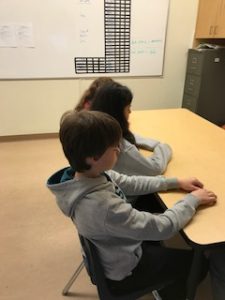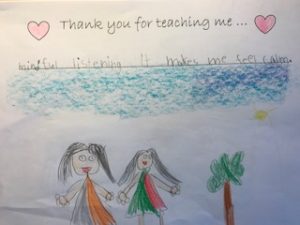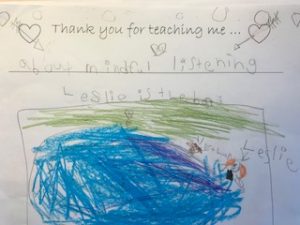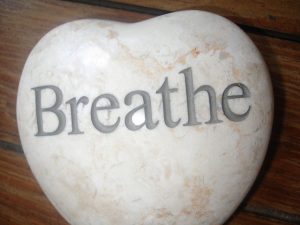Just Breathe
April 26, 2017 - 7 minutes readSelf-regulation continues to be one of West Vancouver Schools’ three pillars, together with Inquiry and Digital Access. Each of these areas has a tremendous impact on student learning and as such, support at the district level is provided for schools. This may include resources, professional development opportunities or specialists who work with school teams. When I reflect on West Bay’s self-regulation journey over the last five years, I know this ‘pillar’ has impacted teaching and learning in a positive way and I am appreciative of the ongoing support we receive.
Leslie Burgess, a member of our district’s self-regulation team, is called upon from time to time to support implementation of self-regulation strategies in classrooms. During a recent visit to West Bay, Leslie and I reflected on the importance of teaching deep breathing to learners of all ages.
Students need to practise deep breathing regularly to ensure they can implement this strategy in stressful situations. Rather than exhibiting a ‘fight-or-flight’ reaction, we want our learners to automatically commence their deep breathing routine. Leslie works with classes to teach students techniques and the value of deep breathing.
In Chantelle McGrath’s Grade One class, students are learning about their ‘upstairs brain’ which is responsible for problem solving, keeping calm and remaining flexible and their ‘downstairs brain’ which helps their bodies stay alert, perceive and feel fear, and maintain control. When the two brains work together students are calm and relaxed. Chantelle reports that:
Practising mindful breathing in our classroom has not only impacted the students but also me. I found that practising breathing on a daily basis students are more calm, focused and flexible which has positively influenced their ability to problem solve and think critically. I have also noticed that as soon as the students are feeling upset, anxious or having trouble problem solving the first thing they do is take deep slow breaths.
We practise mindful breathing in many different ways now – through seated or standing meditation, yoga, music listening and bean bag breathing. The students have gained an appreciation for the feeling of being grounded which translates into a feeling of security for them.
What I am most excited about is how the children are asking to take time in the day to breathe. They are upset when we are not able to practise music listening or our gratitude circle. Furthermore, after practising mindful breathing the students are more calm, patient, respectful and grateful.
As you can see from the messages below, not only did the Grade Ones enjoy their visits from ‘Ms. Leslie’, they also learned important lessons.
Grade Seven teacher Kevin Darling meditates with his class every morning for ten minutes to help his students focus and ‘get in the zone’. When he sees a student getting stressed about an assessment or presentation he simply asks them, ‘Where’s your breathing?’ Kevin reports that the student will suddenly lower their shoulders and begin breathing slower and deeper. Kevin is confident the ten minutes each morning is helping his adolescent learners cope with the many demands placed upon them and will hopefully prove beneficial in high school. A Grade Seven parent commented that she couldn’t believe students were being taught breathing strategies to unblock stress in the brain; she’s noticing a positive difference at home.

After five years, the West Bay staff is having interesting conversations about our self-regulation journey thus far:
- One size does not fit all
- Teachers recognize self-regulation tools and strategies that work for them may not be what their colleagues find calming and effective
- Students understand what they need to be in an optimal learning zone and can appreciate that their needs may vary from those of their peers
- Look at what stressors may be impacting behaviour before trying to ‘fix’ the behaviour (in a previous blog post, I shared examples of the importance of being ‘stress detectives’)
- Teaching breathing strategies is time well spent and benefits everyone
- Teachers feel safe and supported while experimenting with their learning environments and implementing new strategies
- Professional development matters; we enjoy learning together
Next Steps
At the district level our self-regulation team is working with school teams on deepening our understanding of executive functioning. According to Dr. Stuart Shanker, executive functions are the cognitive processes that regulate areas such as planning, working memory, problem solving, mental flexibility, and multi-tasking. All of these skills are vital for functioning successfully in daily life.
Our self-regulation journey continues. Our thinking changes as our world evolves. We assess and address the impact of these changes to help our young learners cope. Most recently, our conversations with parents have focused on screen time and the impact over-stimulation has on the brain. Breathing increases the alpha brainwaves in the prefrontal cortex, the area in the brain responsible for executive functioning. Research indicates that calming the prefrontal cortex through breathing results in improved brain functioning.
I look forward to the next stage of our self-regulation journey. We will continue to hone our practice while exploring ways to support the development of our learners’ executive functioning skills. And of course, I will remember to …




Recent Comments